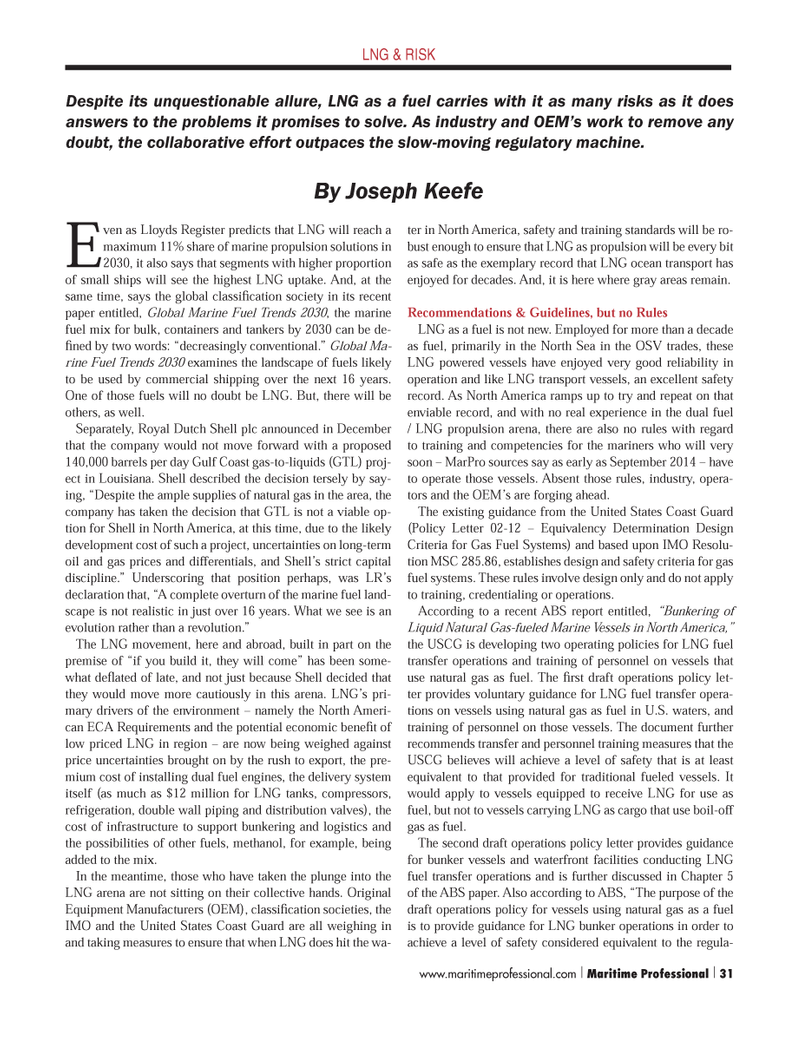
Page 31: of Maritime Logistics Professional Magazine (Q2 2014)
Maritime Risk & Shipping Finance
Read this page in Pdf, Flash or Html5 edition of Q2 2014 Maritime Logistics Professional Magazine
E ven as Lloyds Register predicts that LNG will reach a maximum 11% share of marine propulsion solutions in 2030, it also says that segments with higher proportion of small ships will see the highest LNG uptake. And, at the same time, says the global classifi cation society in its recent paper entitled, Global Marine Fuel Trends 2030, the marine fuel mix for bulk, containers and tankers by 2030 can be de- fi ned by two words: “decreasingly conventional.” Global Ma- rine Fuel Trends 2030 examines the landscape of fuels likely to be used by commercial shipping over the next 16 years.
One of those fuels will no doubt be LNG. But, there will be others, as well.
Separately, Royal Dutch Shell plc announced in December that the company would not move forward with a proposed 140,000 barrels per day Gulf Coast gas-to-liquids (GTL) proj- ect in Louisiana. Shell described the decision tersely by say- ing, “Despite the ample supplies of natural gas in the area, the company has taken the decision that GTL is not a viable op- tion for Shell in North America, at this time, due to the likely development cost of such a project, uncertainties on long-term oil and gas prices and differentials, and Shell’s strict capital discipline.” Underscoring that position perhaps, was LR’s declaration that, “A complete overturn of the marine fuel land- scape is not realistic in just over 16 years. What we see is an evolution rather than a revolution.”
The LNG movement, here and abroad, built in part on the premise of “if you build it, they will come” has been some- what defl ated of late, and not just because Shell decided that they would move more cautiously in this arena. LNG’s pri- mary drivers of the environment – namely the North Ameri- can ECA Requirements and the potential economic benefi t of low priced LNG in region – are now being weighed against price uncertainties brought on by the rush to export, the pre- mium cost of installing dual fuel engines, the delivery system itself (as much as $12 million for LNG tanks, compressors, refrigeration, double wall piping and distribution valves), the cost of infrastructure to support bunkering and logistics and the possibilities of other fuels, methanol, for example, being added to the mix.
In the meantime, those who have taken the plunge into the
LNG arena are not sitting on their collective hands. Original
Equipment Manufacturers (OEM), classifi cation societies, the
IMO and the United States Coast Guard are all weighing in and taking measures to ensure that when LNG does hit the wa- ter in North America, safety and training standards will be ro- bust enough to ensure that LNG as propulsion will be every bit as safe as the exemplary record that LNG ocean transport has enjoyed for decades. And, it is here where gray areas remain.
Recommendations & Guidelines, but no Rules
LNG as a fuel is not new. Employed for more than a decade as fuel, primarily in the North Sea in the OSV trades, these
LNG powered vessels have enjoyed very good reliability in operation and like LNG transport vessels, an excellent safety record. As North America ramps up to try and repeat on that enviable record, and with no real experience in the dual fuel / LNG propulsion arena, there are also no rules with regard to training and competencies for the mariners who will very soon – MarPro sources say as early as September 2014 – have to operate those vessels. Absent those rules, industry, opera- tors and the OEM’s are forging ahead.
The existing guidance from the United States Coast Guard (Policy Letter 02-12 – Equivalency Determination Design
Criteria for Gas Fuel Systems) and based upon IMO Resolu- tion MSC 285.86, establishes design and safety criteria for gas fuel systems. These rules involve design only and do not apply to training, credentialing or operations.
According to a recent ABS report entitled, “Bunkering of
Liquid Natural Gas-fueled Marine Vessels in North America,” the USCG is developing two operating policies for LNG fuel transfer operations and training of personnel on vessels that use natural gas as fuel. The fi rst draft operations policy let- ter provides voluntary guidance for LNG fuel transfer opera- tions on vessels using natural gas as fuel in U.S. waters, and training of personnel on those vessels. The document further recommends transfer and personnel training measures that the
USCG believes will achieve a level of safety that is at least equivalent to that provided for traditional fueled vessels. It would apply to vessels equipped to receive LNG for use as fuel, but not to vessels carrying LNG as cargo that use boil-off gas as fuel.
The second draft operations policy letter provides guidance for bunker vessels and waterfront facilities conducting LNG fuel transfer operations and is further discussed in Chapter 5 of the ABS paper. Also according to ABS, “The purpose of the draft operations policy for vessels using natural gas as a fuel is to provide guidance for LNG bunker operations in order to achieve a level of safety considered equivalent to the regula-
By Joseph Keefe
Despite its unquestionable allure, LNG as a fuel carries with it as many risks as it does answers to the problems it promises to solve. As industry and OEM’s work to remove any doubt, the collaborative effort outpaces the slow-moving regulatory machine.
LNG & RISK www.maritimeprofessional.com | Maritime Professional | 31 18-33 Q2 MP2014.indd 31 5/16/2014 2:53:57 PM

 30
30

 32
32
